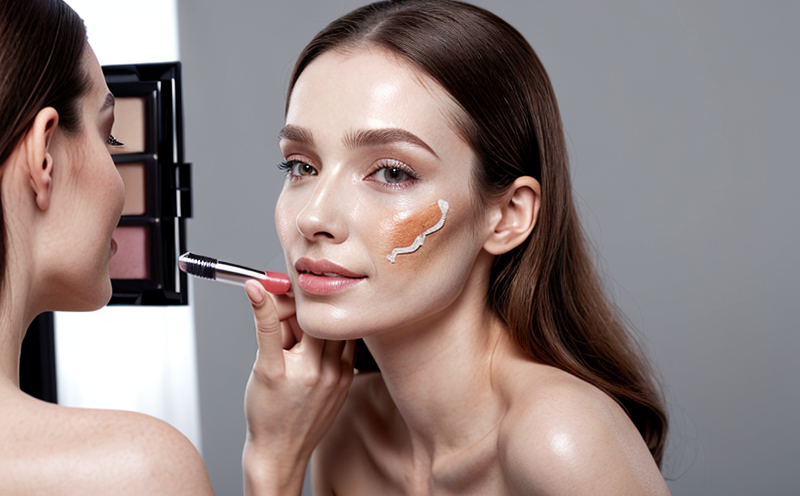Dermatological Tolerance Testing in Eye Creams
Dermatological tolerance testing is a critical process for the development and quality assurance of cosmetic products, especially those that come into direct contact with sensitive areas like the eyes. Eye creams represent one of the most delicate categories within cosmetics due to their proximity to the ocular surface, which is highly susceptible to irritation and allergic reactions. This testing ensures that the product does not cause any adverse effects on the skin around or in the eye area.
The process involves subjecting the sample (eye cream) to controlled exposure to human subjects under standardized conditions. The aim is to observe the reaction of the skin over a specified period, typically ranging from 24 hours up to 7 days. This helps determine whether the product causes any irritation or allergic responses. The test can be performed using either the ocular patch test method or the in vitro method if live subjects are not used.
The key parameters for this testing include the formulation's pH level, viscosity, and the presence of preservatives and other active ingredients that could potentially irritate the eyes. In some cases, the test may also involve a formaldehyde release from preservatives like methylparaben or propylparaben, which can cause allergic reactions.
The laboratory typically requires a batch of the cosmetic product to be tested, along with detailed formulation data and safety information. Once received, the sample is prepared according to ISO 10993-10:2009 standards for dermal irritation tests. The test subjects are usually healthy volunteers who have no known ocular conditions.
The results of this testing are crucial not only for ensuring product safety but also for meeting regulatory requirements set by various countries and international organizations such as the European Union Cosmetics Regulation, FDA guidelines in the United States, and standards like ISO 10993-10. Compliance with these regulations is mandatory to ensure that the products can be marketed globally.
This testing is particularly important for eye creams because even minor irritations around the eyes can lead to discomfort or long-term damage if not addressed properly. The results of this test can help manufacturers make necessary adjustments in formulation, such as reducing the concentration of certain ingredients or changing the preservative system used.
Industry Applications
- Developing safe and effective products: Testing helps ensure that new formulations are safe for use around sensitive areas like the eyes.
- Compliance with regulations: Ensures adherence to international standards and local laws regarding cosmetic safety.
- Enhancing brand reputation: Demonstrates commitment to product safety, which can improve consumer trust and loyalty.
Why Choose This Test
The need for this testing arises from the potential risks associated with products coming into direct contact with sensitive areas. The ocular region is particularly prone to irritation due to its thinner skin compared to other parts of the body, making it more susceptible to adverse reactions. By conducting these tests early in the product development cycle, manufacturers can identify and rectify any issues before the product reaches the market.
The test also helps protect the company from potential legal and financial risks associated with product recalls or lawsuits due to product-related injuries. It is a proactive approach that ensures the safety of consumers while maintaining brand integrity.
Industry Applications
- Product Development: Provides insights into the formulation's potential irritancy and allergic reactions.
- Regulatory Compliance: Ensures adherence to global standards like ISO 10993-10:2009, FDA regulations, and EU Cosmetics Regulation.
- Patient Safety: Protects consumers from potential ocular irritation or allergic reactions by identifying problematic ingredients early in the development process.
- Brand Reputation: Enhances consumer trust through demonstrated commitment to product safety.
Why Choose This Test
The primary reason for choosing this test is the high risk of ocular irritation associated with products that come into direct contact with the eyes. The thin, delicate skin around the eyes makes them particularly susceptible to adverse reactions. By conducting these tests early in the product development cycle, manufacturers can identify and rectify any issues before the product reaches the market.
The test also helps protect the company from potential legal and financial risks associated with product recalls or lawsuits due to product-related injuries. It is a proactive approach that ensures the safety of consumers while maintaining brand integrity. Additionally, compliance with international standards like ISO 10993-10:2009, FDA regulations, and EU Cosmetics Regulation is mandatory for marketing products globally. This testing guarantees adherence to these stringent requirements.
International Acceptance and Recognition
Dermatological tolerance testing in eye creams has received widespread acceptance across various international standards and regulatory frameworks. The European Union Cosmetics Regulation, FDA guidelines in the United States, and ISO 10993-10:2009 are among the key documents that mandate this type of testing.
The European Union's Cosmetics Regulation requires all cosmetic products to undergo safety assessment before being placed on the market. This includes a detailed examination of the product’s ingredients and their potential risks, which often involves dermatological tolerance tests for eye creams.
In the United States, the FDA has specific labeling requirements that include information about any known adverse reactions or irritancy associated with the product. Dermatological testing is crucial in meeting these requirements to ensure accurate labeling.
The International Organization for Standardization (ISO) also provides guidelines through its standard ISO 10993-10:2009, which specifies procedures and criteria for dermal irritation tests. This standard ensures consistency and reliability across different testing facilities worldwide.





